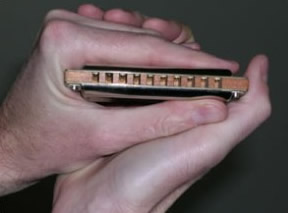Wah-wah

By lifting one or more fingers on the left hand, opening the right hand alone, or throwing both hands open together, we can produce the well known ‘wah-wah’ effect. The vocal equivalent would be an alternation between a closed ‘mmm’ (or hum) and an open ‘aaah’. On the harp however, our hand movement adds an interim ‘www’ sound to the mix. Repeated slowly, the result is a ‘mwah-mwah’ sound. Accelerated, this becomes the straight ‘wah-wah’. Reducing this process to one rapid opening (or ‘throw’) of the hands and a symultaneous attack on the reed makes the harp ‘bark’.
The wah-wah can be played acoustically without mic or amp. It can also be played semi-acoustically into a free standing vocal microphone. Best not to actually touch the mic however, and also to have a sound check beforehand to avoid any feedback.
Once you progress to using a separate hand-held harp mic, you will find that only a semi wah-wah is attainable as your hands are already busy holding the harp and mic.
A related effect is the hand vibrato – the ‘campfire’ sound. This is produced by rapidly fluttering the outermost hand as we play, normally with the fingers extended vertically, although you could also use a cupped, semi-cupped or open hand hold.


No comments:
Post a Comment